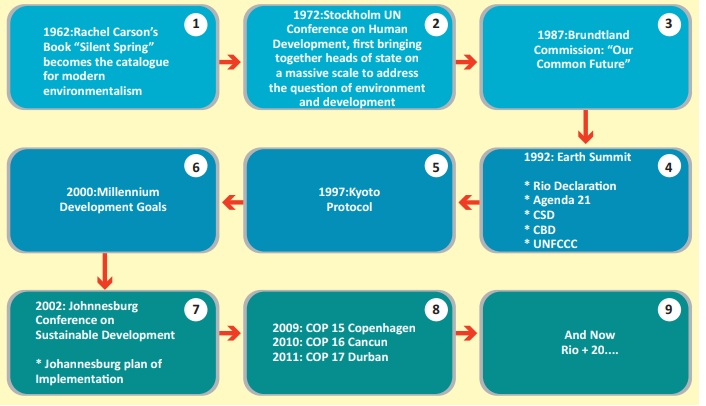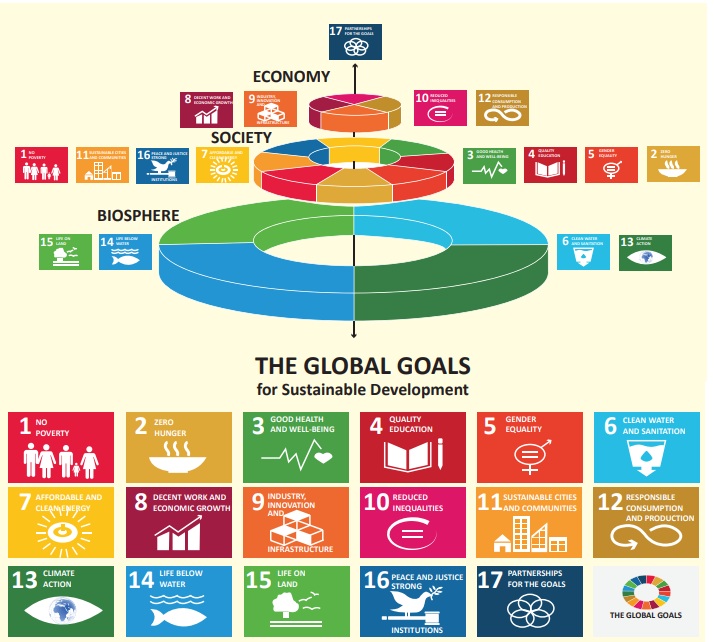Geography - Concept and Goals of Sustainable Development | 12th Geography : Chapter 7 : Sustainable Development
Chapter: 12th Geography : Chapter 7 : Sustainable Development
Concept and Goals of Sustainable Development
Concept and Goals of Sustainable
Development
In 1980 the International Union for the
Conservation of Nature introduced the term "sustainable development".
Sustainable development is development that meets the needs of the present without
compromising the ability of future generations to meet their own needs.
A primary goal of sustainable development
is to achieve a reasonable and equitably distributed level of economic wellbeing
that can be continued for many human generations.

Sustainable Development Goals (SDGs)
In 1992, the UN Conference on Environment
and Development published the Earth Charter, which outlined the building of a just,
sustainable, and peaceful global society in the 21st century. The action plan was
known as ‘Agenda 21’ for sustainable development.
In September 2015, the United Nations
General Assembly formally adopted the "Universal, integrated and transformative"
2030 Agenda for Sustainable Development, a set of 17 Sustainable Development Goals
(SDGs). The goals are to be implemented and achieved in every country from the year
2016 to 2030.
Countries adopted a set of goals to end
poverty, protect the planet and ensure prosperity for all as part of a new sustainable
development agenda. Each goal has specific targets to be achieved over the next
15 years.
For the goals to be reached, everyone
needs to do their part: governments, the private sector, civil society and people.

Goal 1: End poverty in all its forms everywhere
One in five people in developing countries
still live on less than $1.90 a day, many people risk slipping back into poverty.
Economic growth must be inclusive to provide sustainable jobs and promote equality.
Goal 2: End hunger, achieve food security and improved nutrition and promote
sustainable agriculture
Agriculture, forestry and fisheries can
provide nutritious food for all and generate decent incomes, while supporting people-centred
rural development and protecting the environment. A profound change of the global
food and agriculture system is needed if we are to nourish today’s 815 million hungry
and the additional 2 billion people expected by 2050.
Goal 3: Ensure healthy lives and promote well-being for all at all ages
Significant strides have been made in
increasing life expectancy and reducing some of the common killers associated with
child and maternal mortality. Major progress has been made on increasing access
to clean water and sanitation, reducing malaria, tuberculosis, polio and the spread
of HIV/AIDS.
Goal 4: Ensure inclusive and quality education for all and promote lifelong
learning
Major progress has been made towards
increasing access to education at all levels and increasing enrolment rates in schools
particularly for women and girls. For example, the world has achieved equality in
primary education between girls and boys, but few countries have achieved that target
at all levels of education.
Goal 5: Achieve gender equality and empower all women and girls
Gender equality is not only a fundamental
human right, but a necessary foundation for a peaceful, prosperous and sustainable
world.
Goal 6: Ensure access to water and sanitation for all
Clean, accessible water for all is an essential part of the world we want to live in. There is sufficient fresh water on the planet to achieve this. But due to bad economics or poor infrastructure, every year millions of people, most of them children, die from diseases associated with inadequate water supply, sanitation and hygiene. By 2050, at least one in four people is likely to live in a country affected by chronic or recurring shortages of fresh water.
Goal 7: Ensure access to affordable,
reliable, sustainable and modern energy for all
Energy is central to nearly every major
challenge and opportunity the world faces today. Sustainable energy is opportunity
– it transforms lives, economies and the planet.
Goal 8: Promote inclusive and sustainable economic growth, employment and
decent work for all
Sustainable economic growth will require
societies to create the conditions that allow people to have quality jobs that stimulate
the economy while not harming the environment. Job opportunities and decent working
conditions are also required for the whole working age population.
Goal 9: Build resilient infrastructure, promote sustainable industrialization
and foster innovation
Inclusive and sustainable industrial
development is the primary source of income generation, allows for rapid and sustained
increases in living standards for all people, and provides the technological solutions
to environmentally sound industrialization.
Goal 10: Reduce inequality within and among countries
To reduce inequality, policies should
be universal in principle paying attention to the needs of disadvantaged and marginalized
populations.
Goal 11: Make cities inclusive, safe, resilient and sustainable
Cities are hubs for ideas, commerce,
culture, science, productivity, social development and much more. At their best,
cities have enabled people to advance socially and economically Common urban challenges
include congestion, lack of funds to provide basic services, a shortage of adequate
housing and declining infrastructure.
Goal 12: Ensure sustainable consumption and production patterns
Sustainable consumption and production
is about promoting resource and energy efficiency, sustainable infrastructure, and
providing access to basic services, green and decent jobs and a better quality of
life for all. Its implementation helps to achieve overall development plans, reduce
future economic, environmental and social costs, strengthen economic competitiveness
and reduce poverty.
Goal 13: Take urgent action to combat climate change and its impacts
Climate change is now affecting every
country on every continent. It is disrupting national economies and affecting lives,
costing people, communities and countries dearly today and may be even more tomorrow.
Goal 14: Conserve and sustainably use the oceans, seas and marine resources
The world’s oceans – their temperature,
currents and life – drive global systems that make the earth habitable for humankind.
Careful management of this essential global resource is a key feature of a sustainable
future.
Goal 15: Sustainably manage forests, combat desertification, halt and reverse
land degradation, halt biodiversity loss
Forests cover 30 per cent of the Earth’s
surface and in addition to providing food security and shelter, forests are key
to combating climate change, protecting biodiversity and the homes of the indigenous
population. Thirteen million hectares of forests are being lost every year while
the persistent degradation of dry lands has led to the desertification of 3.6 billion
hectares.
Goal 16: Promote just, peaceful and inclusive societies
This Goal is dedicated to the promotion
of peaceful and inclusive societies for sustainable development, the provision of
access to justice for all, and building effective, accountable institutions at all
levels.
Goal 17: Revitalize the global partnership for sustainable
development
A
successful sustainable development agenda requires partnerships between governments,
the private sector and civil society. These inclusive partnerships built upon principles
and values, a shared vision, and shared goals that place people and the planet at
the centre, are needed at the global, regional, national and local level.
Fact File
Paris Agreement
To address climate change, countries adopted the Paris Agreement at the COP21 in Paris on
12 December 2015. The Agreement entered into force shortly thereafter, on 4 November
2016. In the agreement, all countries agreed to work to limit global temperature
rise to well below 2°C, and given the grave risks, to strive for 1.5°C.
Related Topics